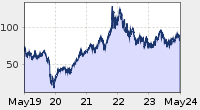adsense
Oil rises above $114 falls towards $112 on storm threat, stimulus hopes
 8:47 AM
8:47 AM
 Unknown
Unknown
Oil rises above $114 falls towards $112 on storm threat, stimulus hopes
he euro zone's blue chip Euro STOXX 50 index was down about 0.1 percent after the Ifo data at 2,431.10 points, although volumes were thin as the British market, Europe's largest, was shut for a public holiday.
The main German stock index was little changed, recovering some of its earlier losses, as some of the Ifo institute's findings were not as bad as many feared.
The euro also rose to $1.2530 after the Ifo survey was released, up 0.15 percent on the day, but was holding below a peak of $1.2590 set last Thursday.
Analysts said the weaker outlook in Europe's biggest economy could also support political efforts to find a solution to the region's fiscal crisis, in part by supporting arguments made by German Chancellor Angela Merkel and European Central Bank President Mario Draghi.
"The declining growth rate in Germany shows that the country is not immune from the general slowdown in Europe and outside Europe," said BNP Paribas economist Dominique Barbet.
"This could help Merkel and Draghi convince German people that more efforts to support the euro zone are necessary and are in the interest of Germany."
Crude oil futures reversed earlier gains to fall towards $112 a barrel on concerns that a tropical storm would shut U.S. refineries and as western governments mulled the release of strategic reserves to calm oil prices.
Tropical Storm Isaac swirled into the Gulf of Mexico on Monday and began approaching the Louisiana refining hub, prompting U.S. energy companies to start shutting refineries and raising prospects for a jump in crude oil stocks.
Brent crude futures were down by $1.59 at $112 a barrel by 1359 GMT after earlier falling more than $2.
U.S. crude was down by $1.35 at $94.80.
"With refineries shutting down along the U.S. Gulf Coast, traders are weighing this up and seeing there may be a glut of crude oil in the market," Carl Larry, analyst at OilOutlooks in New York said.
"Isaac is also adding to talk of a possible release from the Strategic Petroleum Reserve, so traders are cautious at these levels after a 2-month long rally," he added.
Marathon Petroleum Corp said on Monday it was initiating the shutdown of its 490,000 barrels-per-day (bpd) refinery in Garyville, Louisiana.
In another indication that regional crude stocks could rise, a fire burned for a third day at Venezuela's biggest refinery on Monday, raising doubts about a speedy restart to operations.
Oil prices have risen nearly 30 percent since June with international sanctions hitting Iranian exports and maintenance affecting North Sea oil flows.
Reuters reported that the White House was "dusting off" old plans for a possible release on fears that rising oil prices could undermine the effect of sanctions on Iran.
Brent crude futures were up $1.04 at $114.63 a barrel by 1022 GMT. U.S. crude was up $1.0 at $97.20.
Tropical Storm Isaac swirled into the Gulf of Mexico on Monday and meteorologists at Weather Insight, an arm of Thomson Reuters, predict the storm will spur short-term shutdowns of 85 percent of the U.S. offshore oil production capacity.
"The storm is probably helping but there's better sentiment generally. Everybody is waiting to see if Jackson Hole will be a turning point for commodities," said Eugen Weinberg, global head of commodities research at Commerzbank.
Central bankers and economists are due to meet in Jackson Hole, Wyoming later this week where Fed Chairman Ben Bernanke will deliver a speech that will be scoured for clues on a third round of quantitative easing.
He told a Congressional oversight panel in a letter that the Federal Reserve has room to deliver additional monetary stimulus to boost the U.S. economy.
The markets will also look for policy signals from the euro zone ahead of a September 6 meeting of the European Central Bank. RESOURCES
Oil Prices Could Sky-rocket Despite Low Demand 2012-2013
 8:12 AM
8:12 AM
 Unknown
Unknown
 |
| Source: U.S. EIA, August 22, 2012 |
Top Asian buyers — China, India, Japan and South Korea together take more than half of Iran’s crude oil exports — have worked around the European Union embargo, suggesting imports will stay at least around these levels for the rest of the year.And here’s how these energy hungry Asian economies get around the ban by the U.S. and EU:
South Korea joined its Chinese counterparts by asking Iran to deliver crude on Iranian tankers, government and industry sources said. This shifts to Tehran the responsibility for insurance, sidestepping the EU ban.Very Few Compelling Price Drivers
Indian refiners have adopted a twin plan to deal with the insurance issue. They are seeking government approval to ask Tehran to deliver the oil, and are trying to use limited cover from state-run insurers for locally-owned tankers to ship it.
Growth in emerging economies in Asia, particularly China, has been the main driver of oil-demand growth in recent years. However, currently, there’s no such compelling story of strong demand and supply shortage that drove oil price to 2008 highs.
Near Term Market Movers
Although the supply and demand factors do not seem to support the current price levels in crude and gasoline, there are plenty of other events to sustain and add the risk/fear/speculation premium.
- The worse-than-forecast tropical storm Isaac is expected to strengthen to a Category 2 hurricane and hit the Gulf Coast at midweek disrupting refineries and offshore oil production. Crude and gasoline futures already partly reflected this risk premium. US gasoline prices could really spike is any of the refineries are off line.
- Petroleum Economist cited unnamed sources on Friday that IEA has agreed to a coordinated SPR (Strategic Petroleum Reserves) release with the U.S. in September. However, during the IEA coordinated SPR release last summer (due to Libyan civil war), oil price managed to climb back to where it was before the release in just eight days.
- Federal Reserves Chairman Bernanke’s often times market-moving speech at Jackson Hole meeting on Aug. 31.
- New bailout and stimulus package development from the Euro Zone and/or China.
- Geopolitics in the Middle East
Gas Price Remaining High When Oil Price Is Going Down
 7:33 AM
7:33 AM
 Unknown
Unknown
Gas Price Remaining High When Oil Price Is Going Down
Crude Oil and Commodity Prices
August, Monday 27 2012 - 10:04:26
|
| ||||||||||||||||||||||||||||||||||||
| Crude Oil Price by OIL-PRICE.NET © |
| ||||||||||||||||||||||||||||||||
Euro Crisis
US strategic petroleum
Logic would seem to dictate that if oil prices are going down, the price of gasoline should follow suit and go down also.
However the opposite has been observed lately. Of course as is the case in any fluctuation of oil prices, there is a range of reasons responsible for this.
So why exactly is the price of oil dropping whilst the price of gasoline at the pump is remaining high
The US also has the largest emergency oil supplies in the world. The release of oil from strategic petroleum reserves pushes prices down as the supply of oil is increased. In fact, even a statement to the effect that the government is considering the release of emergency oil supplies is enough to knock oil prices down. One only has to look at what happened in March 2012 when President Obama released a joint statement with the British Prime Minister David Cameron, announcing that both the UK and US were considering the release of emergency oil supplies. This alone was enough to have an immediate effect on oil prices and knock them down.
Gas Prices Affect Consumers
Inflation and a weak dollar are also a major component in the domestic cost of production and distribution of gasoline. While crude oil prices depend extensively on geopolitical factors, the price of gasoline is more subject to domestic factors such as inflation.
Blame Iran, Really
Scenarios for and the gold price trends 2013
 5:28 AM
5:28 AM
 Unknown
Unknown
Gold price forecasts 2013
Outlook on Gold 2013 and beyond
Golds prices trends, forecast, and prospects 2013
 5:13 AM
5:13 AM
 Unknown
Unknown
Gold 2013 ??? the trend for the gold price in 2013 and beyond?
Gold price forecast trend chart for 2011, 2012, 2013, 2014, 2015, 2016
The gold price forecast trend chart is as shown in the chart below for the years 2011 to 2016.
Like all other commodity Gold price are also driven by basic rule of supply and demand. Demand of gold is categorized mostly in four sector i.e Reserve bank (central bank), jewelry, industrial & investment.
Other governing factor for gold price in 2013 and beyond will be global financial situation. Global financial situation is not so good today, level of debt taken by western countries are not sustainable. They are trying hard to improve financial situation either by taking more debt or by reducing current debts. Eventually this situation is causing significant rise in inflation rates & rise in value of western currencies.
Forecast by
|
Forecasted Gold Rate in Ounce
|
Converted Rate per
10 gm in Rs/- |
Year
|
BNP Paribas |
2280 $ | 38635 Rs/- | 2013 |
Thomson Reuters GFMS |
2000 $ | 33890 Rs/- | 2013 |
Morgan Stanley |
2175 $ | 36856 Rs/- | 2013 |
Newmont Mining |
2500 $ | 42363 Rs/- | 2013 |
Standard Chartered |
2000 $ | 33890 Rs/- | 2013 |
Standard Chartered |
2107 $ | 35703 Rs/- | 2014 |
Some forecast may seem to be speculations but one thing is for sure that from here gold price are intended to appreciate more. This may be due to economic uncertainties, unfortunately the global financial problems are not yet sorted out, you might have heard about bad financial situation about Europe and other western countries. This may cause gold price to rise further.
So, looking at global demand and other economic factors gold price will continue to rock in 2013 & beyond. Invest in gold today for brighter tomorrow.
Gold will set record high in future but when that time will only show us.
We will bring you the latest updates on the same as they happen. Stay tuned to Strategic Growth by following Strategic Growth Official Facebook Page and sign up for our free newsletter.

 Posted in
Posted in 







 1.45 1.51%
1.45 1.51% 














